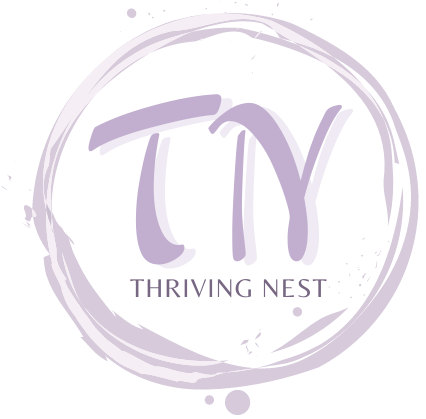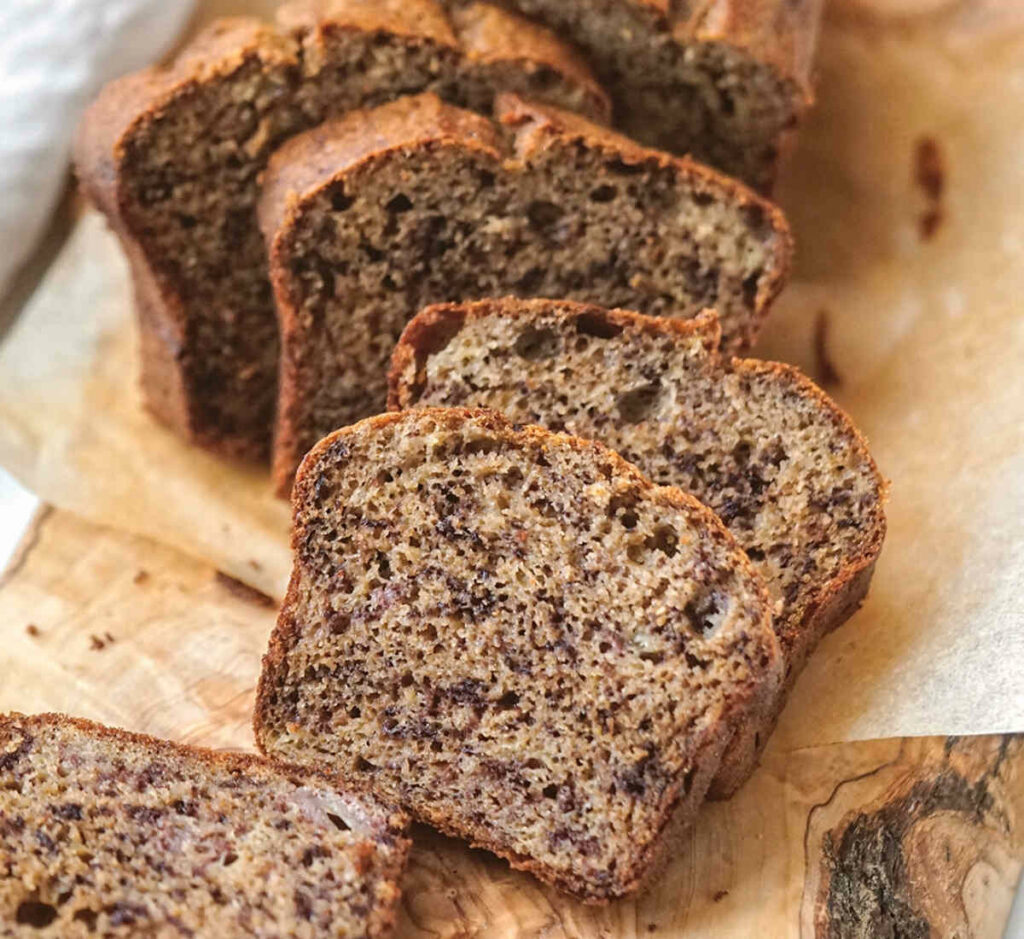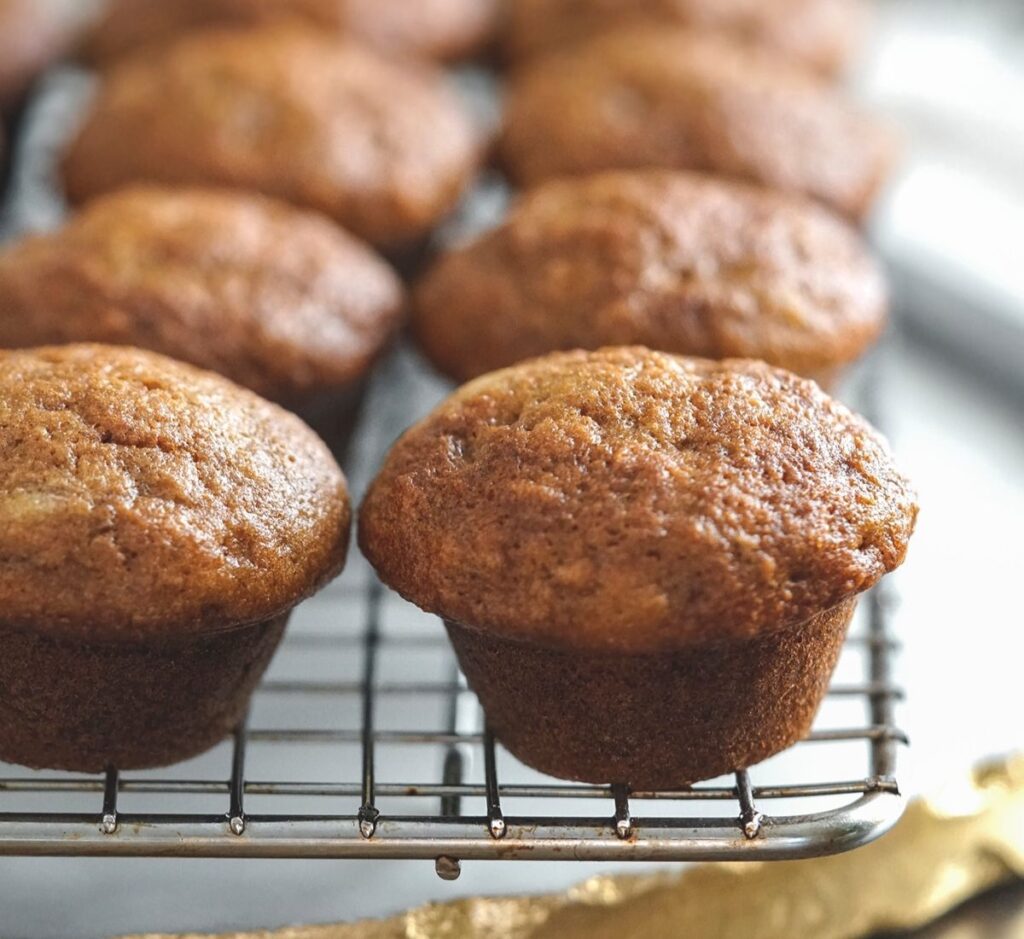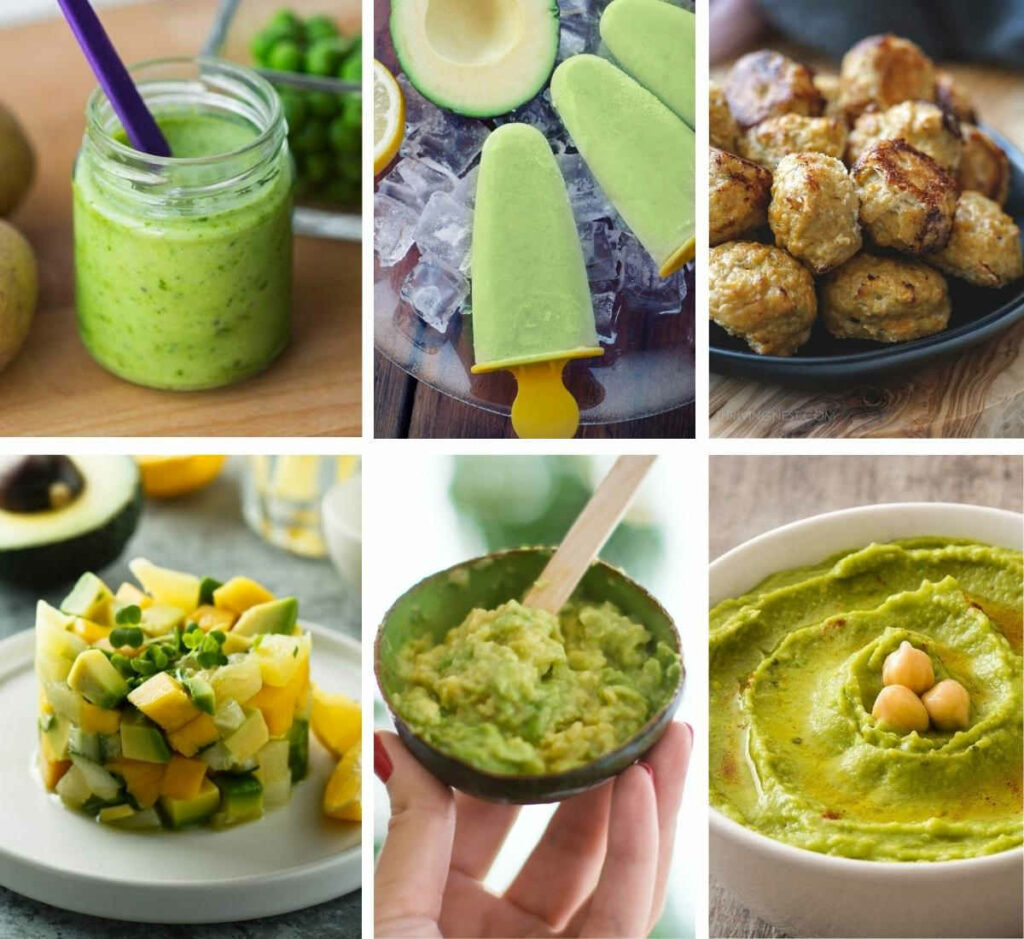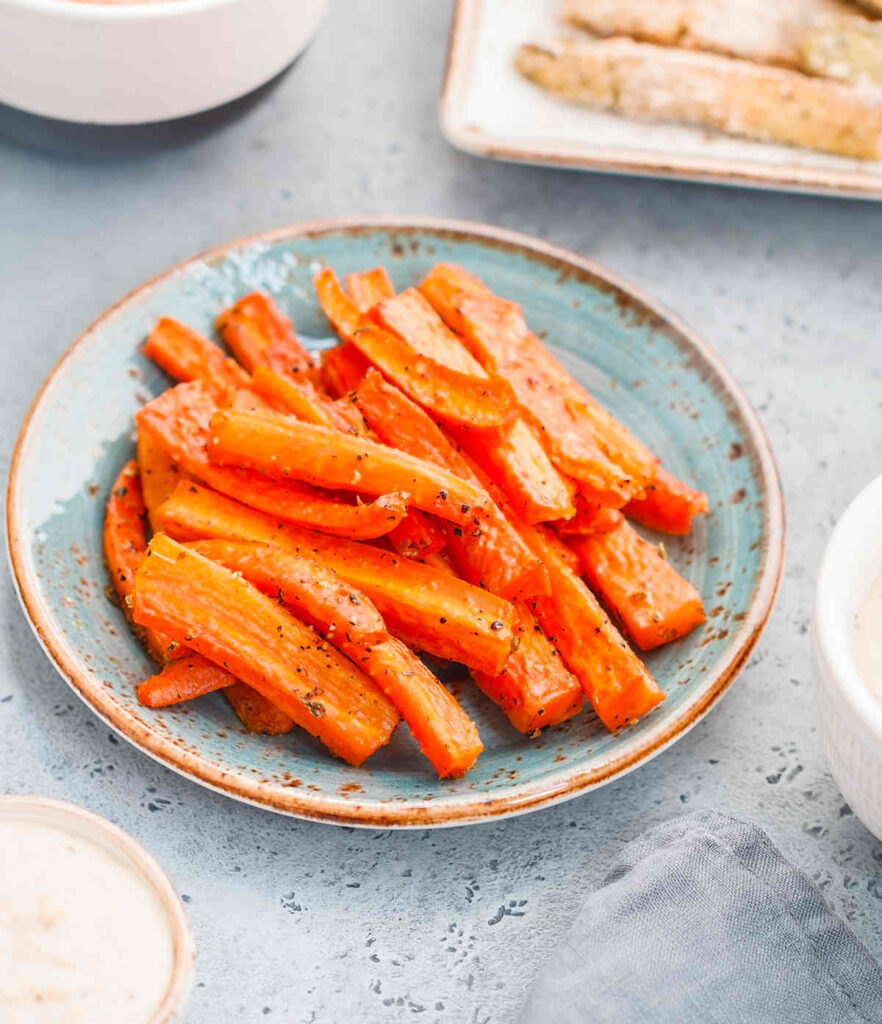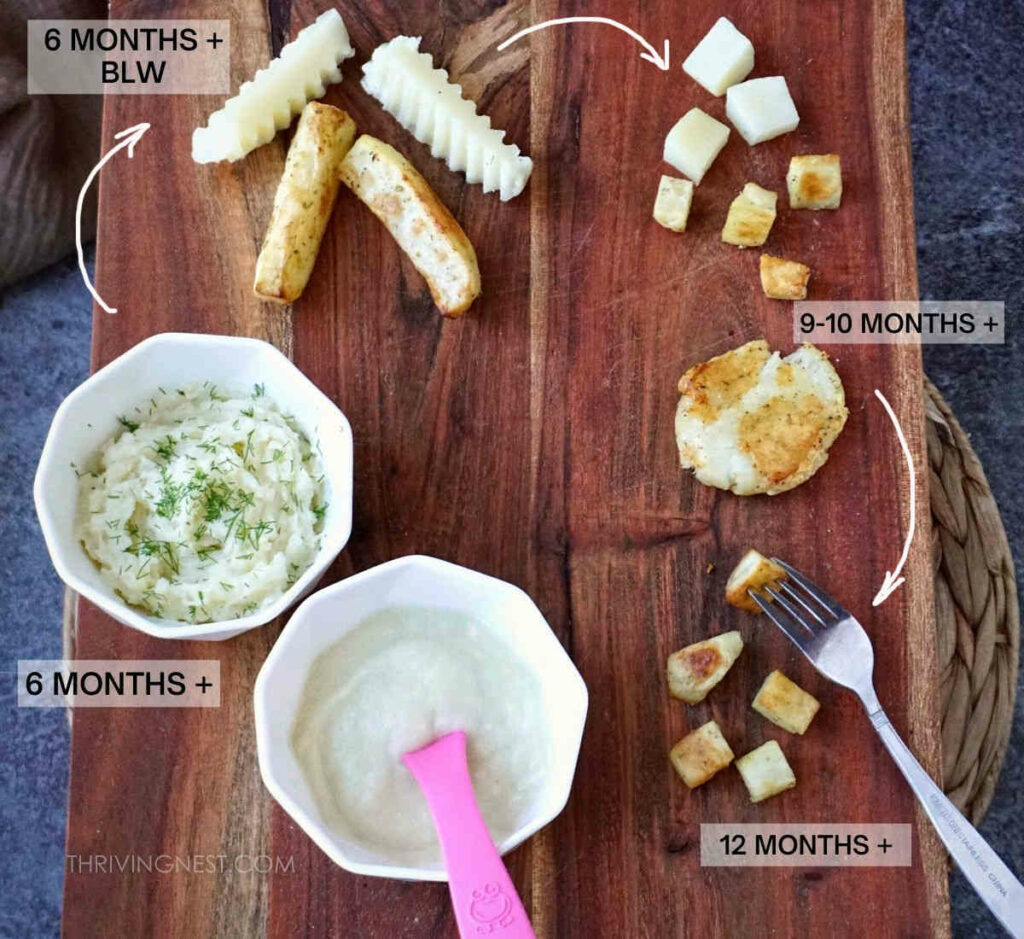Cauliflower For Baby Ways To Cook & Serve (BLW)
Cauliflower (meaning “cabbage flower”) has been cultivated from wild cabbage and it’s full of nutrients and antioxidants that are essential for our kid’s gut health and immune system. You can definitely add this vegetable to your baby’s diet starting around 8 months – steamed, puréed, mashed, grated, roasted or incorporated in finger foods, it makes a nutritious baby food including for baby led weaning.
What Age Can Baby Have Cauliflower
You can start serving cauliflower to your baby around the age of 7-8 months old. As this cruciferous vegetable is known for causing bloating and gas you should avoid serving it as first food. It’s probably best to wait until your baby’s sensitive gut is more accustomed to insoluble fibers before introducing it.
Every child is different so whenever you choose to start feeding cauliflower to your baby, pay attention if any discomfort occurs.

How To Cut Cauliflower For Baby Led Weaning
- Remove the stalk, then start removing the florets by cutting each cluster from the core, leaving a little of the stem with each cluster.
- Keep larger florets for babies who start baby led weaning at 6-8 months. Once your baby develops teeth and a pincer grasp (typically around 9 months), cut the cauliflower into smaller pieces (florets). They will enjoy picking up smaller finger food.
- Introduce cauliflower rice to your baby at around 12 months when he already knows how to chew and swallow foods. To reduce the chocking hazard help your child bind the individual grains in his mouth by mixing with a sauce or cheese.
Below you’ll find more information about how to cook and serve cauliflower for baby led weaning.
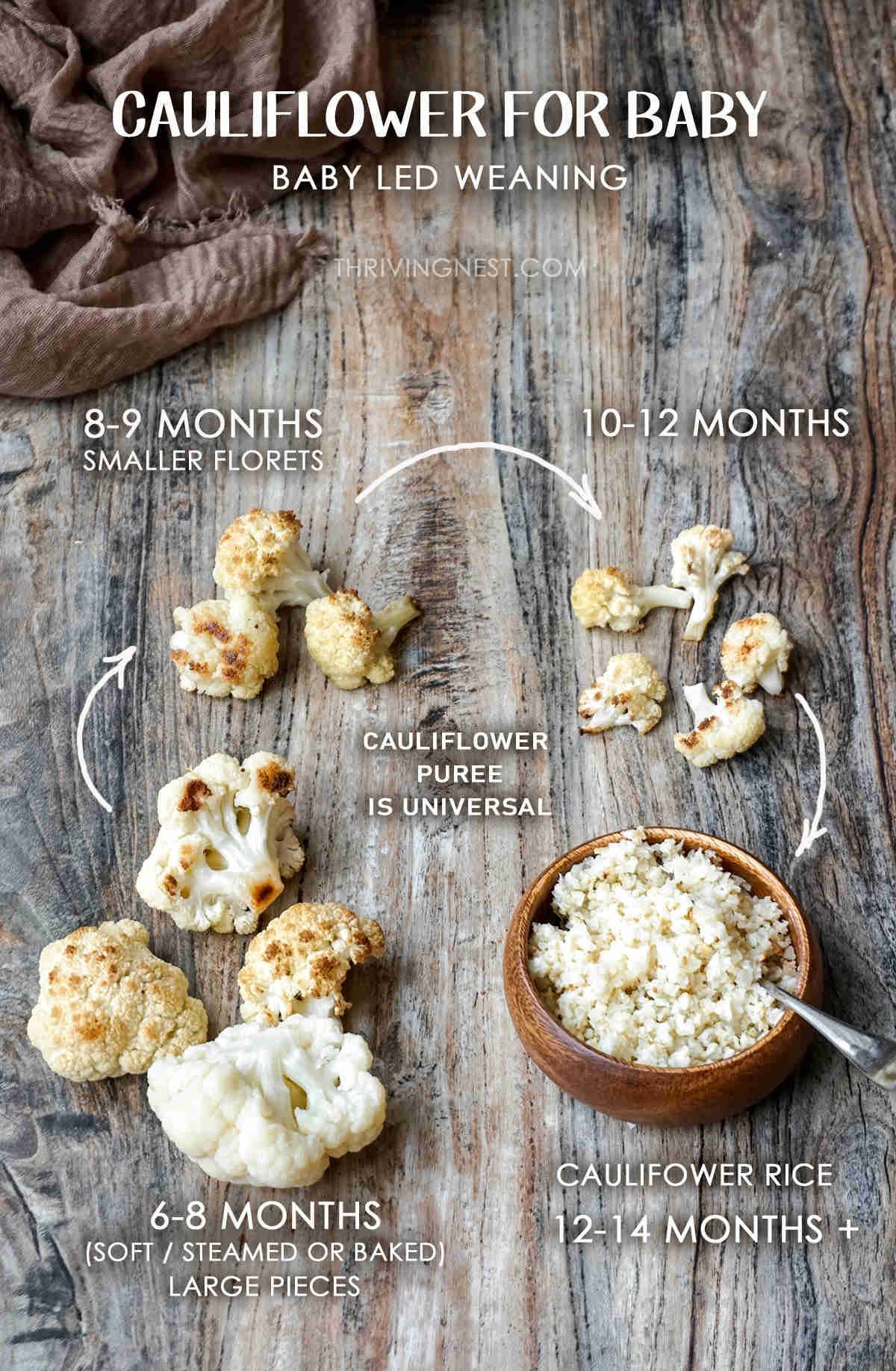
How To Cook Cauliflower For Baby (BLW) & Toddlers
Cauliflower whether is purple, yellow or orange is one of the world’s most nutrient-dense vegetables and it needs proper temperature and cooking time in order to preserve as much as possible of those nutrients.
TIP: High-temperature cooking practices such as boiling, frying and high-power microwave processing can degrade the bioavailability of cauliflower’s beneficial compounds. If you want to minimize the cauliflower’s odor while retaining the nutrient content, cook the cauliflower for only a short time like 10-13 minutes. And choose methods that require a small amount of water.
Some common methods of cooking cauliflower are steaming, roasting, sautéing, and boiling.
Here are the best ways you can cook cauliflower for you baby:
Steaming Cauliflower For Baby
Steaming the cauliflower is one of the best way of preserving its nutrients, due to less contact with water and short time of cooking. Here is how to do it:
- Add enough water to a pot and bring to a boil ( it should not touch the steamer basket when it is placed in the pot).
- Place the steamer basket with cauliflower pieces over the pot. Cover and cook for 6 to 8 minutes or until tender when pierced with a fork. Cooking time will depend on the size of the florets.
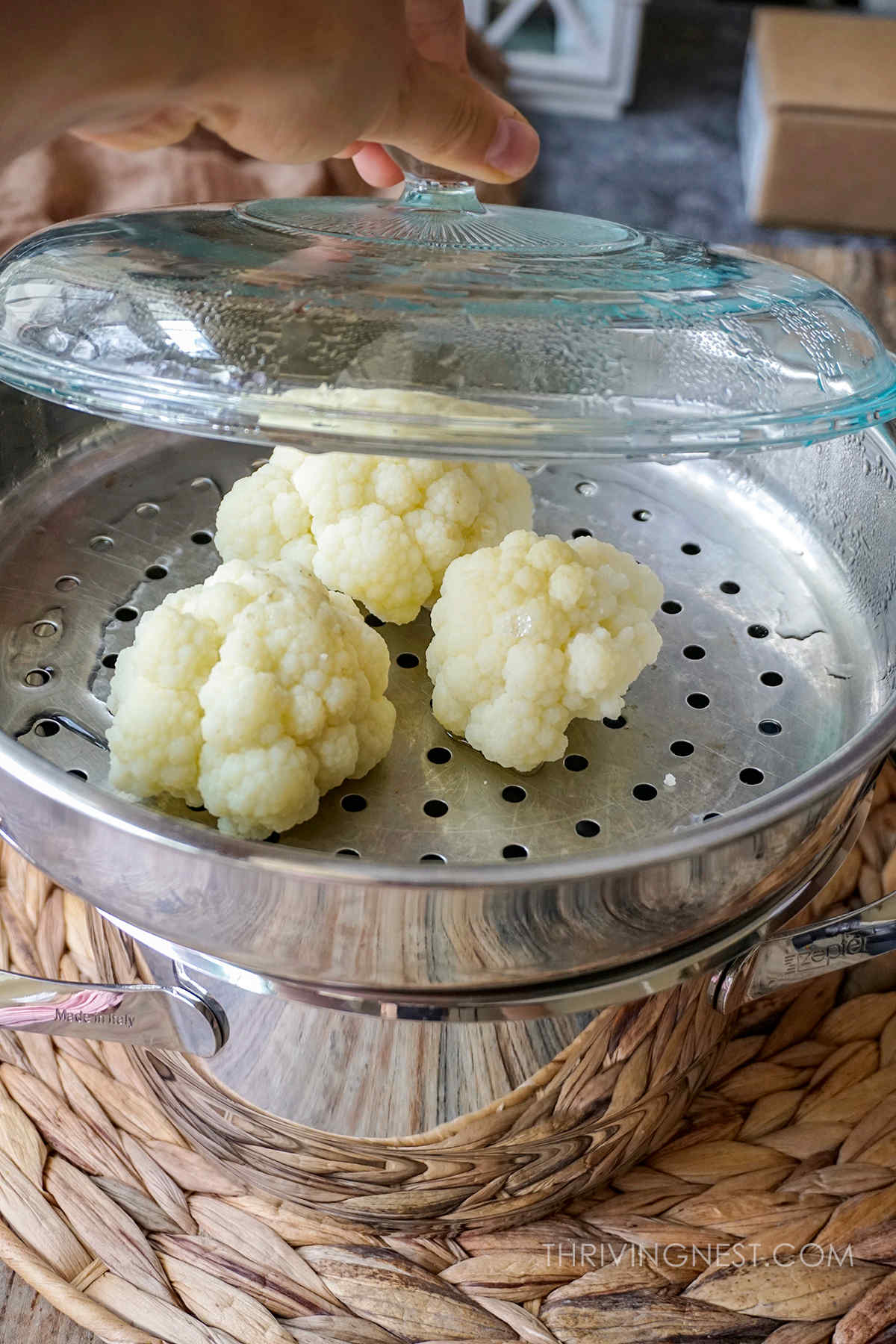
How To Roast Cauliflower For Baby (As Finger Food)
The remarkable taste of roasted cauliflower comes as a result of caramelization in the oven. Here’s how to roast cauliflower to get the perfect texture and taste:
- Cut cauliflower into florets. You can keep larger florets for younger babies (6-8 months) or you can cut them down further by cutting each cluster into smaller uniform size pieces. These are perfect as finger food for babies 9 months and older.
- Place the cauliflower on a baking sheet in a single layer.
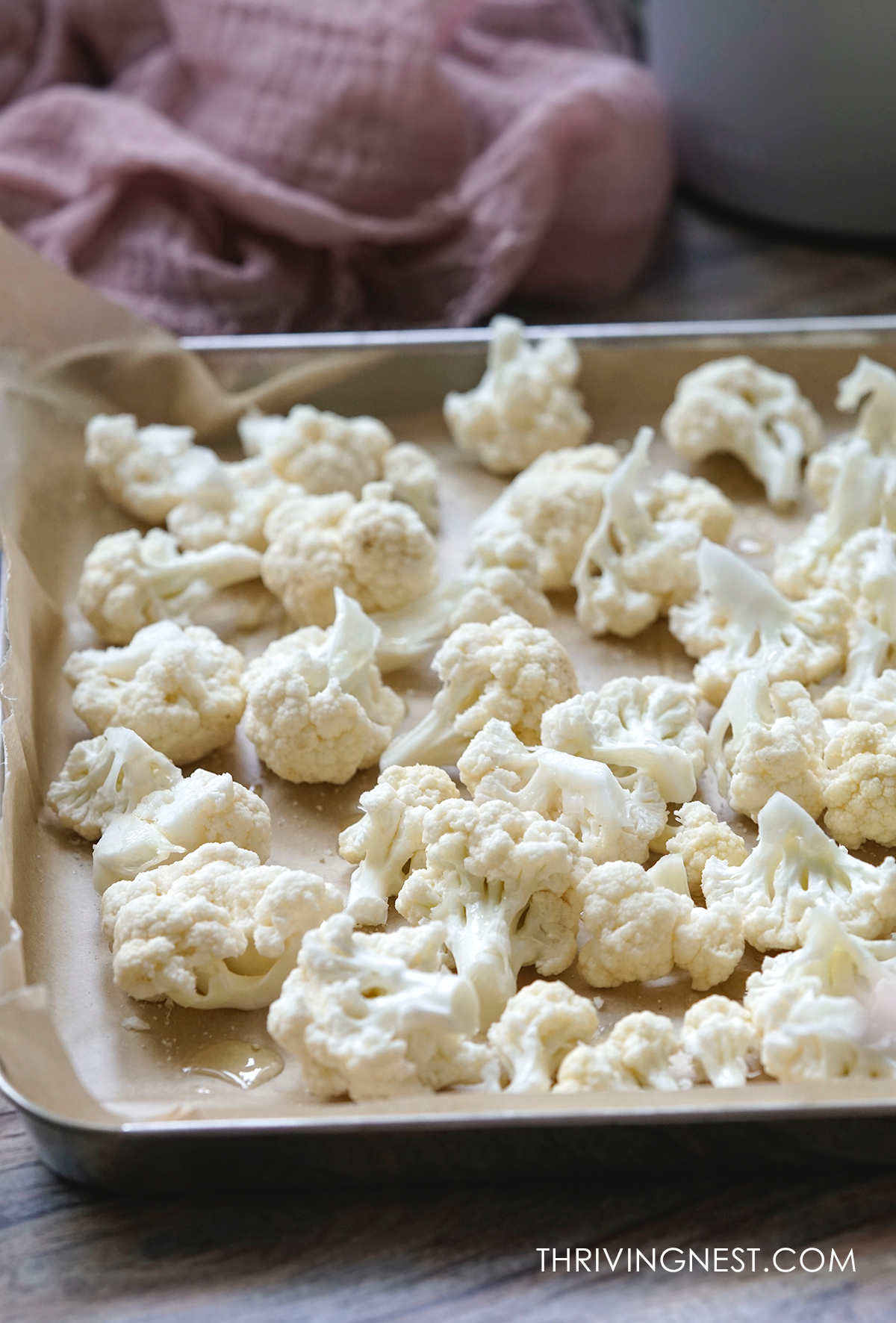
3. Drizzle some oil on top and season with sea salt and black pepper (for older kids).
4. Roast cauliflower in the preheated oven at 425F / 220C, for 35-40 minutes.
Boiling Cauliflower For Baby
Boiling the cauliflower usually is the least preferred method if you need to serve just plain soft cauliflower florets. The most nutrients will leach into the boiling water that you will likely discard. To be more exact, half of nutrients are lost when it is boiled for only 10 minutes. This method is best when you make soups and purees as you would keep the water with all the leached nutrients.
Cauliflower Rice For Baby (BLW)
It’s pretty simple to make cauliflower rice. I like to roast the cauliflower first (just as described above) and then simply grind the roasted cauliflower florets in the food processor until they become roughly the size of rice. Babies (12 months +) will love the cauliflower rice, it’s fun to eat and goes well with other baby food. Cauliflower rice is also great for baby led weaning too!
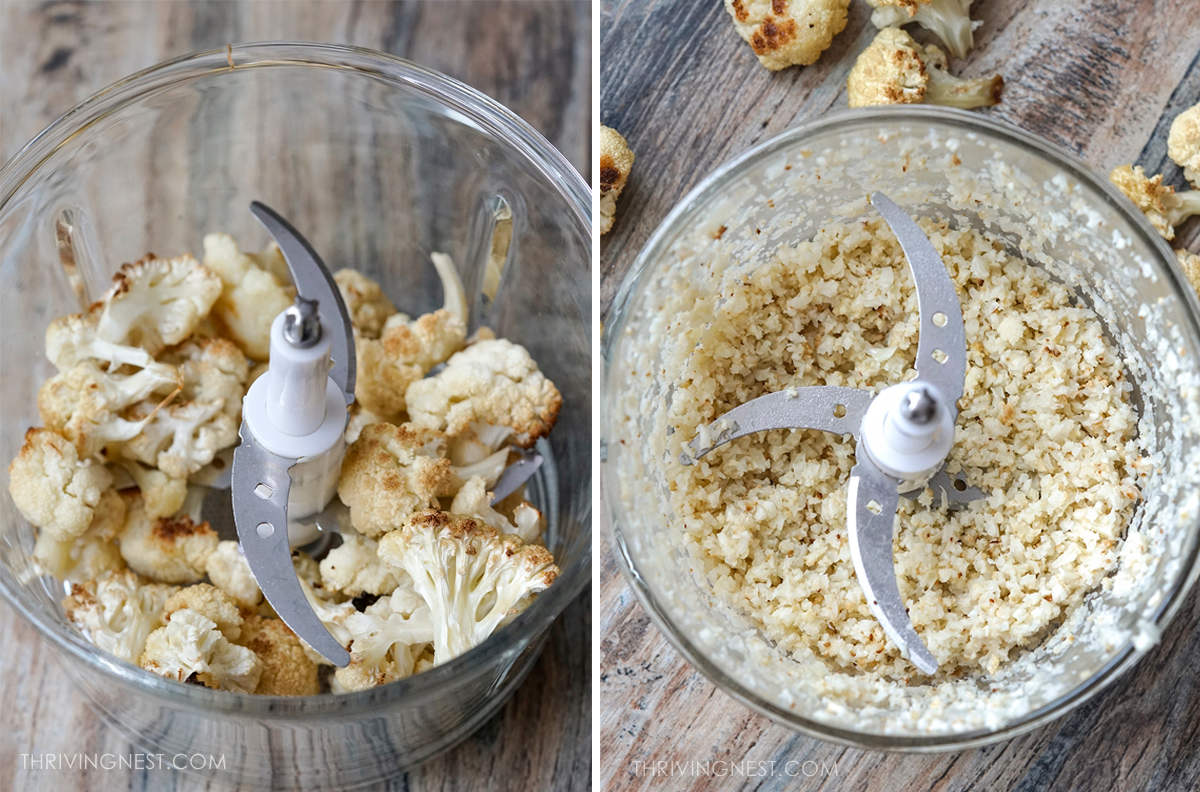
This post may contain affiliate links. To read the disclaimer policy See This.
Tips For Cooking Cauliflower
- For even cooking, ensure that the cauliflower florets are assembled in a single layer or evenly distributed in the steam basket.
- Do not overcook cauliflower. Overcooking will turn it mushy, loose its color, most of it’s nutrients and change in taste.
- The perfectly cooked cauliflower should have a crisp-tender texture.
- If roasting cauliflower try to use healthier, high smoke point oils like avocado oil or grape-seed oil.
How To Puree Cauliflower For Baby (Stage 1)
You can make baby cauliflower puree by itself with a very smooth and soupy texture. This is usually suitable for babies between 6-8 months of age or for baby-led weaning.
After baking, roasting or steaming, you just take the cooked cauliflower, mash or puree the cauliflower in a blender until smooth.
Cauliflower Baby Food Puree Combinations (Stage 2)
After a while of stage 1 (single-ingredient purees), your baby will probably start expressing readiness for the next phase (stage 2 – typical for babies 8-9 months of age and older): more kinds of food, thicker textures and larger portions.
Here are some great cauliflower puree combinations:
- Cauliflower and apple (applesauce) or pear
- Prune Avocado Cauliflower Puree
- Cauliflower and butternut squash
- Cauliflower and chicken
- Cauliflower chickpea and corn
- Cauliflower and carrot
- Cauliflower and avocado and banana
- Cauliflower and pumpkin or squash
- Cauliflower and potato or sweet potato
- Cauliflower and salmon
- Cauliflower and zucchini
Cauliflower Baby Led Weaning / Finger Food Recipes
- Cauliflower Nuggets
- Cauliflower Thins – Healthy Bread Alternative
- Cauliflower egg muffins
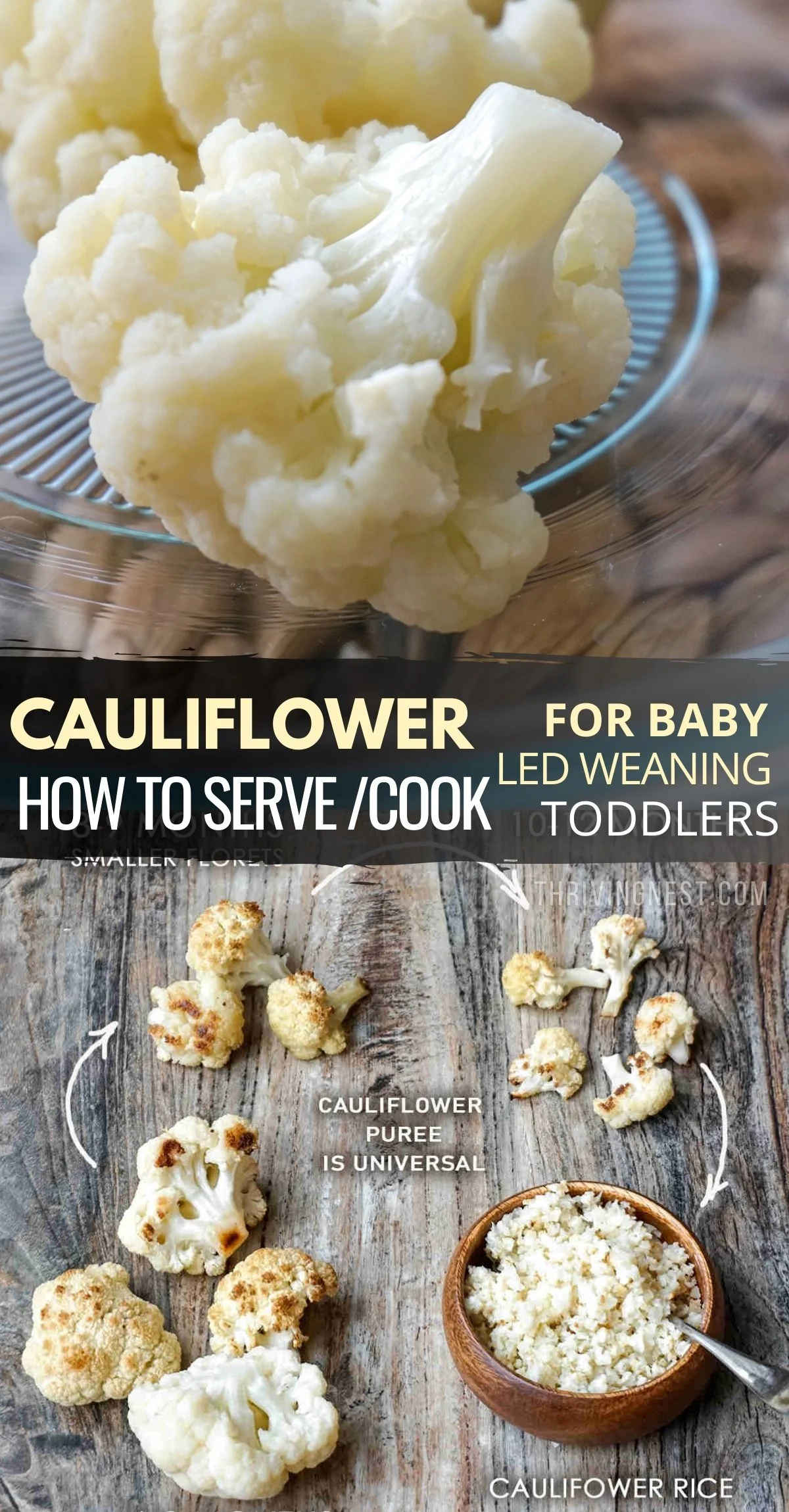
Cauliflower FAQ
Cruciferous vegetables are harder to digest (due to high fibre content) and can cause gas and bloating, so it is not recommended as first baby food, especially for infants who have a more sensitive digestive system.
Yes. You can freeze the cauliflower puree for your baby for up to 2-3 months. The longer it sits some texture and taste changes will start to take place.
Depends on the the size of cauliflower florets. For medium 2 inch florets – about 5 to 6 minutes. It should be cooked until tender but still firm enough to keep its integrity.
Due to its high soluble fibre content cauliflower might help with baby constipation. For best results try to mix with some prune puree. Some babies though have a problem with complex sugars contained in cruciferous vegetables so they may find it harder to digest.
Sneak into other purees, finger foods and try to roast it instead of steaming, it tends to taste better. And don’t give up, offer it multiple times and show it by example.
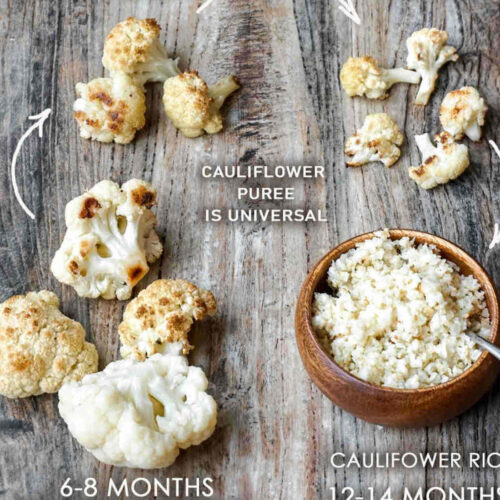
Cauliflower For Baby Ways To Cook & Serve (Puree & Baby Led Weaning)
Ingredients
- 1 small head of cauliflower (remove the florets)
- 2 tbsp avocado oil (if roasting)
- 1/3 tsp sea salt (for older kids)
Instructions
- Remove the stalk, then start removing the florets by cutting each cluster from the core, leaving a little of the stem with each cluster. Divide into smaller florets if you need smaller pieces.
Steaming Cauliflower
- Add enough water to a pot and bring to a boil ( it should not touch the steamer basket when it is placed in the pot).
- Place the steamer basket with cauliflower pieces over the pot. Cover and cook for 6 to 9 minutes until tender when pierced with a fork. Cooking time will depend on the size of the florets.
Roasting/Baking Cauliflower
- Place the cauliflower on a baking sheet in a single layer. Drizzle some oil on top and season with some sea salt (optional).
- Roast cauliflower in the preheated oven at 425F / 220C, for 35-40 minutes.
Boiling Cauliflower
- Boiling is the same as steaming, but this time you drop the cauliflower in the pot covered with water and boil for approximately 10 minutes or until tender. Keep in mind, the most nutrients will leach into the boiling water. This method is best when you make soups and purees as you would keep the water with all the leached nutrients.
Cauliflower Puree Stage 1
- After baking, roasting or steaming, you just take the cooked cauliflower, mash or puree the cauliflower in a blender until smooth. Add water as needed to reach the desired consistency. No salt or spices needed.
Cauliflower Puree Stage 2
- Same procedure as with stage 1 but you can make a thicker texture, mix with other purees and serve larger portions. See puree combinations in the notes below.
Notes
Tips For Cooking Cauliflower
- For even cooking, ensure that the cauliflower florets are assembled in a single layer or evenly distributed in the steam basket.
- Do not overcook cauliflower. Overcooking will turn it mushy, lose its color, change its taste, and will lose lots of nutrients.
- The perfectly cooked cauliflower should have a crisp-tender texture.
- If roasting cauliflower try to use healthier, high smoke point oils like avocado oil or grape-seed oil.
Cauliflower Puree Combinations:
- Cauliflower and apple (applesauce) or pear
- Cauliflower, prune and avocado
- Cauliflower and butternut squash
- Cauliflower and chicken puree
- Cauliflower chickpea and corn
- Cauliflower and carrot
- Cauliflower and avocado and banana
- Cauliflower and pumpkin or squash
- Cauliflower and potato or sweet potato
- Cauliflower and salmon
- Cauliflower and zucchini
Nutrition
Disclaimer: The information, including but not limited to, text, graphics, images and other material contained on this website are for informational purposes only and not intended for medical advice. Please refer to my full disclaimer for more info.
©ThrivingNest. Content and photographs are copyright protected and need prior permission to use. Copying and/or pasting full recipes to other websites and any social media is strictly prohibited. Sharing and using the link of this recipe is both encouraged and appreciated!
